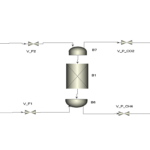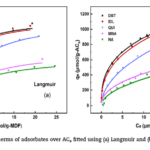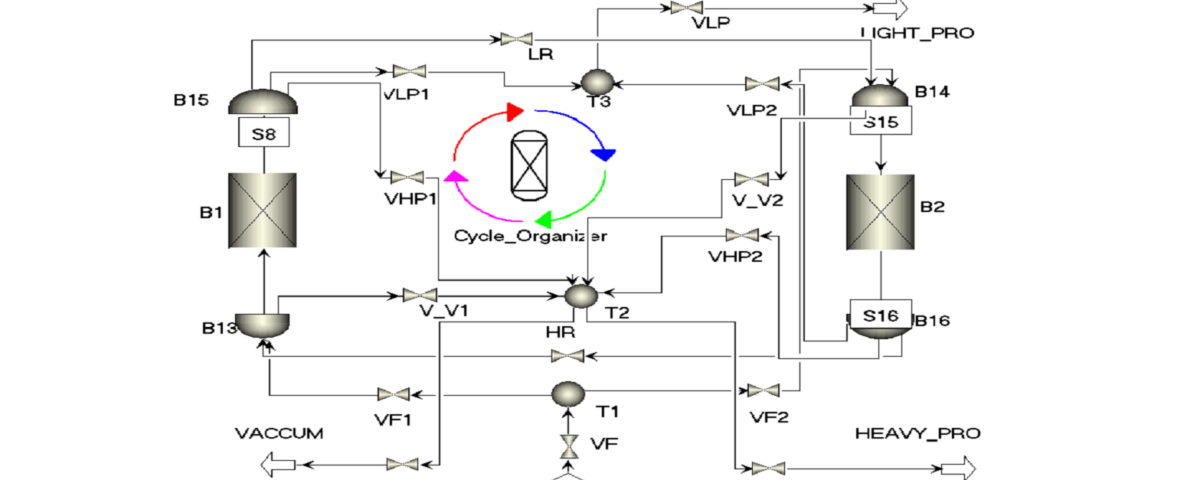Introduction
Excessive consumption of fossil fuels and, as a result, emission of greenhouse gases, including carbon dioxide (CO₂), is one of the main environmental challenges of today. Carbon dioxide is known as the main cause of global warming. And it has destructive effects on the global climate. In order to reduce the harmful effects of this gas on the environment, the development of efficient technologies for the separation and storage of CO₂ is of particular importance.
One of the effective methods for separating CO₂ from gas mixtures is Pressure Swing Adsorption or PSA. In this process, porous solid adsorbent materials are used to selectively absorb CO₂ molecules from the gas stream. By periodically changing the pressure, the adsorbed molecules can be separated from the adsorbent surface.
Dual-Reflux Pressure Swing Adsorption or DR-PSA is an advanced type of PSA process that uses two adsorbent beds and several different steps to improve separation performance. By using the recirculation mechanism, the purity and separation efficiency can be increased.
Description of The Process
In this research, from an advanced device for separating carbon dioxide (CO2) from nitrogen (N2). It has been used using the surface adsorption method under pressure (DR PSA). The main penalty of the system is included
Adsorption Beds: two cylindrical columns containing silica gel adsorbents that play a key role in absorbing CO2 molecules.
Gas Injection System: CO2 and N2 mixed gas is injected into the substrates using precise flow controllers.
Pressure Control System: Using a compressor and a vacuum pump, the required pressure changes are created for the adsorption and desorption cycles.
Measurement System: It includes pressure gauges, thermometers and gas chromatograph for accurate measurement of operational parameters and analysis of exhaust gas composition.
Control System: Through solenoid valves and programmable logic (PLC), all process steps are automatically controlled.
Mechanism of Action:
In this method, CO2 and N2 mixed gas is introduced into one of the beds with high pressure. CO2 molecules stick to the silica gel adsorbent surface and are separated from the gas flow. After the adsorbent is saturated, with a decrease in pressure, CO2 molecules are separated from the surface of the adsorbent and leave the system. Meanwhile, the other substrate is being regenerated and prepared for the next adsorption cycle.
The apparatus used in the DR PSA process is shown in Figure 1. Each bed has a height of 1 meter, a radius of 0.03 meters, a wall thickness of 0.002 meters and contains 1.587 kg of silica gel. This system is designed with the aim of studying and optimizing the gas separation process in laboratory conditions.
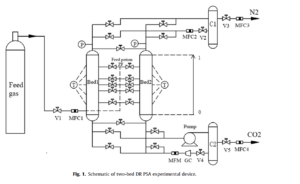
Half Cycle Process
The feed gas containing 15% CO2 and 85% N2 was stored in a steel gas cylinder. The six-step DR-PSA cycle includes an adsorption step, a reduced pressure equalization step, A vacuum stage, a light reflux stage, a re-pressure equalization stage and a heavy depressurization stage. Note that only half a cycle is shown in Figure 2.
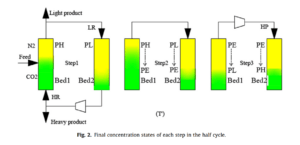
Heavy product (CO2) and light product (N2) are obtained in AD and LR stages, respectively. AD and LR steps are performed simultaneously in one cycle. The feed enters the high pressure (PH) bed1 at the midpoint of bed1. A part of N2 leaves above bed1. The remaining part of N2 is used as light reflow. and is discharged to the low pressure bed bed2. Then, part of the CO2 is removed from the bottom of bed2.
The remaining portion is compressed by the compressor and enters bed1 as a heavy reflux substitute. DPE and RPE steps are performed simultaneously in one cycle. During the pressure equalization steps, the high pressure bed gas flows into the low pressure bed. The pressure (PE) of the two beds is equal at the end of the steps. VU and HP steps are performed simultaneously in one cycle. The HP stage pushes bed 2 from PE to PH by a portion of the heavy reflow. Conversely, bed 1 pressure is reduced from PE to PL through a diaphragm pump in stage VU. Before starting the DR PSA cycle, the substrates were all purged with nitrogen.
Process Simulation
Analysis of DR PSA Simulation Assumptions
The simulation of the DR PSA process was developed using commercial software Aspen Adsorption. Simulation of this process is based on the information and data of the article by Lee et al.
The following assumptions are considered for this process:
Ideal Gas Behavior: Gases are considered as ideal gas.
Uniform Radial Distribution: It is assumed that the gas concentration, temperature and pressure are constant in the radial direction of the bed.
Argon Pressure Drop: Argon equation is used to estimate pressure drop in the bed.
Thermal Equilibrium: It is assumed that the gas and solid temperatures are the same at any point in the bed.
Fixed Porosity: The porosity of the substrate and adsorbent particles is assumed to be the same throughout substrate
Linear Mass Transfer Model: The linear driving force (LDF) model has been used to describe the mass transfer between gas and solid phase.
Non-linear Isotherm: Adsorption isotherm is described using the extended Langmuir model.
Adsorption Isotherms
In this research, the results of CO2 and N2 gas adsorption tests on silica gel adsorbent have been analyzed using the Langmuir isotherm model (Figure 3). The parameters of this model were obtained by matching the laboratory data at different temperatures and pressures (Table 3). The coefficients of the linear mass transfer model (LDF) for these two gases have also been calculated using Aspen Adsorption software and laboratory data. Physical properties of the substrate and gas-solid interaction properties were also measured and entered into the model (Table 4).
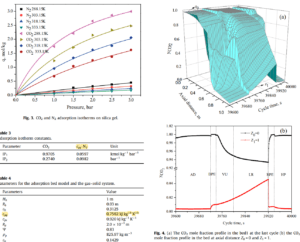
The PSA process is carried out cyclically, and each cycle consists of several consecutive steps. To simulate this process in Aspen Adsorption software, a six-step cycle is considered for a two-bed system. Changes in pressure, temperature, concentration and gas flow during each stage of the cycle have been investigated. By analyzing these changes, the stable state of the cycle can be achieved. For example, Figure 4 shows the changes of CO2 mole fraction in the first bed in steady state.
Simulation Results
This research has investigated the performance of a simulation model for gas separation (PSA) process. SANILCO researchers have evaluated the accuracy of this model by conducting tests under different conditions. Various factors such as gas inlet location, pressure adjustment method and reflux flow rate have been investigated in these experiments. The results show that the simulation model can well predict the actual behavior of the process. As the operating conditions change, the model accurately predicts changes in product purity, pressure, and temperature. The most important findings of this research are:
Effect of gas inlet location: Changing the gas inlet location affects the purity of products and there is an optimal location to maximize purity.
Effect of pressure adjustment method: The pressure adjustment method has an effect on process performance and product recovery.
The influence of light reflux flow rate: changing the reflux flow rate has an effect on energy consumption and product purity.
In summary, this research shows that the used simulation model can be used as a powerful tool for designing and improving gas separation processes. Using this model, engineers can determine the optimal operating conditions to achieve the highest product purity and lowest energy consumption.
Conclusion
By comparing experimental results and simulation of DR PSA process for N2/CO2 separation. It can be seen that the DR PSA model is suitable for the production of N2 and CO2 with high purity and recovery. Also, Aspen Adsorption software can simulate the DR PSA process. In these operating conditions (pressure 200 kPa and temperature 299.65 K), 99.18% purity and 99.62% recovery for CO2 and 99.64% purity and 99.56% recovery for N2 can be achieved.
Simulation of PSA Process for CO2-N2 Separation in ADSIM
In this project, the simulation for CO2-N2 separation with DR PSA pressure fluctuation adsorption process is done in ADSIM software.
